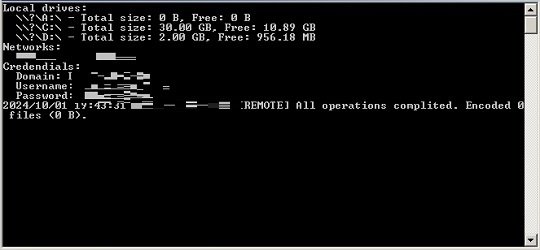Ransom.Win64.LDRADO.THCBOBD
Windows

Threat Type:
Ransomware
Destructiveness:
No
Encrypted:

In the wild::
Yes
OVERVIEW
It arrives on a system as a file dropped by other malware or as a file downloaded unknowingly by users when visiting malicious sites.
TECHNICAL DETAILS
Detalles de entrada
It arrives on a system as a file dropped by other malware or as a file downloaded unknowingly by users when visiting malicious sites.
Instalación
Agrega los procesos siguientes:
- vssadmin Delete Shadows /all /quiet
- cmd "/c chcp 65001 & systeminfo"
Robo de información
Acepta los siguientes parámetros:
- -skip-local → Skip processing local files.
- -skip-net → Skip processing shares
- -keep → Disable self-deletion after execution (Self-deletion is enabled by default).
- -n
→ Specify network in CIDR format. If not specified, values from active network interfaces will be used. A file with a list of networks can also be specified. - -d
→ Specifies a domain. - -u
→ Specifies username for SMB. - -p
→ Specifies password for SMB.
Otros detalles
Hace lo siguiente:
- It gathers the following data via systeminfo:
- Operating System Information:
- Name
- Version
- Manufacturer
- Configuration
- Build Type
- Registered Owner
- Registered Organization
- Product ID
- Installation date
- Host name
- System Boot Time
- System Manufacturer
- System Architecture
- Processor information
- System Language
- Time Zone Information
- BIOS Version
- Total and Available Physical Memory
- Virtual Memory Information (Max, Available, In Use)
- Page file locations
- Domain
- Logon server
- Hotfix(es)
- Network card(s)
- It displays its logs on a console:

- It sends some of its logs to the following IP Address:
- {BLOCKED}.{BLOCKED}.{BLOCKED}.152:443
SOLUTION
Step 2
Los usuarios de Windows ME y XP, antes de llevar a cabo cualquier exploración, deben comprobar que tienen desactivada la opción Restaurar sistema para permitir la exploración completa del equipo.
Step 3
Note that not all files, folders, and registry keys and entries are installed on your computer during this malware's/spyware's/grayware's execution. This may be due to incomplete installation or other operating system conditions. If you do not find the same files/folders/registry information, please proceed to the next step.
Step 4
Buscar y eliminar estos archivos
- {Encrypted Directory}\HOW_RETURN_YOUR_DATA.TXT
- {Encrypted Directory}\HOW_RETURN_YOUR_DATA.TXT
Step 5
Explorar el equipo con su producto de Trend Micro para eliminar los archivos detectados como Ransom.Win64.LDRADO.THCBOBD En caso de que el producto de Trend Micro ya haya limpiado, eliminado o puesto en cuarentena los archivos detectados, no serán necesarios más pasos. Puede optar simplemente por eliminar los archivos en cuarentena. Consulte esta página de Base de conocimientos para obtener más información.
Step 6
Restore encrypted files from backup.
Did this description help? Tell us how we did.


